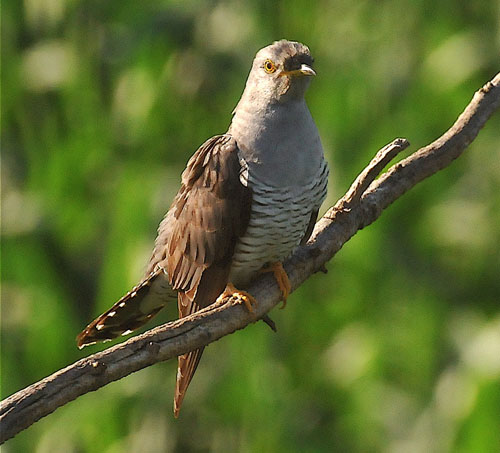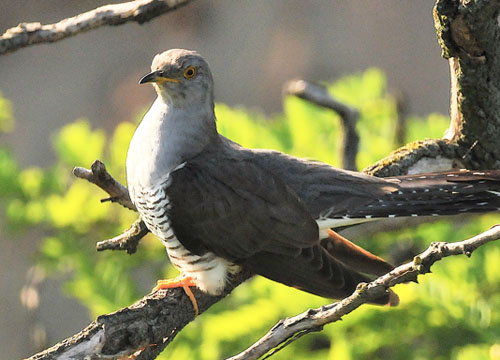
CUCKOO (Cuculus canorus)
(Home)

The cuckoo is one of the best-known of our summer visitors, more by its call than by its appearance, as it is one of those birds which tells us its name (the chiff-chaff is another). The call can travel considerable distances, but at the same time it can be very deceptive; sometimes it seems to originate far away and then one sees the bird in a nearby tree. The hearing of the first cuckoo is often a cause for celebration, worthy of many a letter in the correspondence columns of The Times. It stirs pleasant thoughts of the coming warm season:
Summer is icumen in,
Lhude sing cuccu.
as the medieval song has it. The cuckoo arrives in Britain from March onwards. A record kept in recent years reveals that the first arrival in the Sulgrave area has regularly occurred at or near the end of the third week in April.
In appearance the cuckoo resembles a hawk or a falcon, with longish tail, pointed wings, grey back and barred chest. It eats mainly insects and especially caterpillars. The widespread use of insecticides in agriculture may be a prime cause of the cuckoo’s decline in numbers.
The bird is of course well known for its unusual custom of laying its eggs in the nests of other species. The six most common hosts are pied wagtail, robin, meadow pipit, sedge warbler, reed warbler and dunnock. Each female cuckoo seems to favour a single host species and has the remarkable ability to lay eggs which more or less match in colour those of the other bird. She watches carefully to locate the position of the host’s nest, and as soon as the first egg is laid in it, she moves in when the other bird is absent, removes the egg and, in no more than a second or two, lays her own egg there instead. The nest-owner goes on to lay the rest of her clutch, but when the cuckoo chick hatches out, it throws any nestlings or remaining eggs out of the nest. The cuckoo can then monopolise the attentions of its “mother” until it enormously outgrows her in size. Another example of the marvels and mysteries which evolve in the intricate inter-relationships of our world’s species!

Photos: John Sheppard. Text: George Metcalfe.
See Bird Archive for other birds in this series.